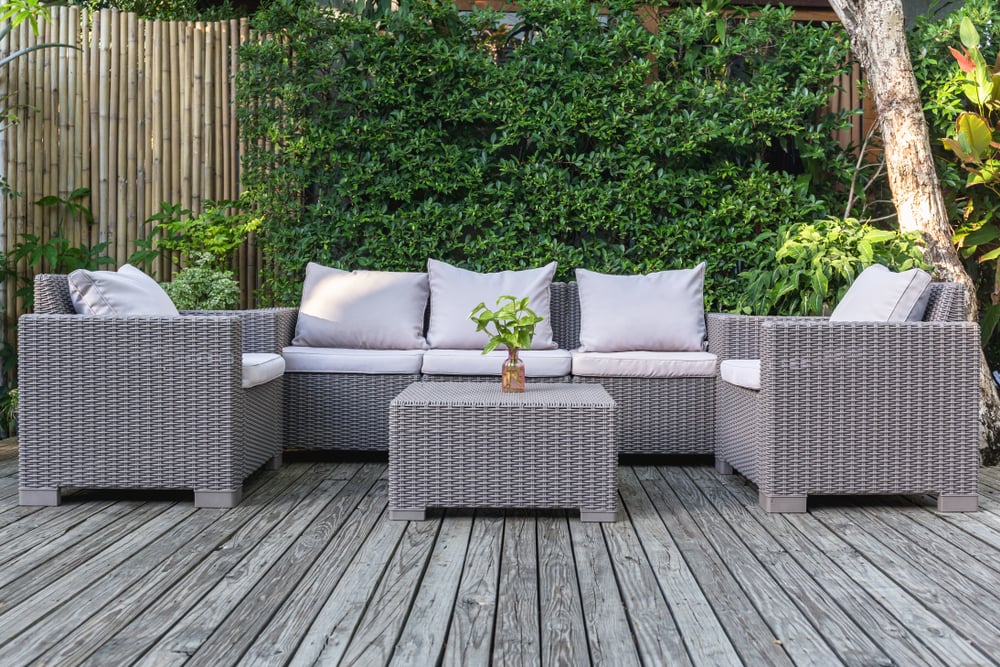Patios vs. Decks – Which One is Best for You?

As the weather warms, we naturally want to spend more time outdoors, whether to relax, exercise, or entertain. And where better to enjoy these activities than in the comfort of your own home.
Adding a patio or deck to your home can expand your living space dramatically and allow you to share it with family and friends. But which is best for you – a patio or deck?
What Are the Differences?
Decks are typically attached to a house and are generally made of wood. Due to constant exposure to the weather, the wood must be sealed or pressure-treated, or else it will be damaged over time. A deck can be elevated (like a balcony) or it can sit at ground level (like a patio). When built above ground, they work well on sloped or uneven areas.
In contrast, patios are built at ground level and can be attached to a house or freestanding. Compared to a deck, patios can be constructed from a wide variety of materials – from concrete to gravel. As a result, patios generally last longer than decks and are usually less expensive to build.
Planning & Design
When planning for the design of your deck or patio, there are several things to keep in mind:
Size – Make sure your new deck or patio is large enough for its intended use. For example, if you plan to dine there, it must be large enough to accommodate your table and chairs, with an extra 4 feet of space around the table, so people can easily walk behind those who are seated.
Test out the size of your deck or patio by marking out the space with stakes and string. Also, buy your outdoor furniture first and then arrange it to make sure it fits comfortably in the space you have in mind.
Features – A deck or patio can be used for all sorts of things – from a place to unwind to a venue for entertaining family and friends. So you will have to decide what design elements to include in your plan, such as lighting, fire pits, grilling equipment, pergolas, planters, etc.
Construction Materials
The most important decision you’ll make is deciding what materials to use to build your deck or patio. There are all kinds of materials available; it’s usually a function of your budget and personal taste.
As mentioned previously, decks are typically made of wood or a wood composite but there are still a lot of choices:
- Pressure-treated wood – It’s waterproof, easy to stain, and low cost. But it’s not as good-looking as some options and can twist or split during installation.
- Cedar & Redwood – Both are easy to work with, weather to a nice gray color, and have a natural insect resistance. But they are not easy to maintain and not available everywhere, so the cost will depend on your region.
- Tropical Hardwood – This product can last for ages if properly cared for and it has a natural insect resistance. But it’s expensive and hard to install.
- Composite - This is a mix of wood and plastic, so there are lots of options for colors and textures. It won’t rot or break, and you don’t need to seal, paint, or stain it. But it will get lighter in color over time, so you might choose a deeper color initially.
Patios can be constructed from all sorts of materials. The most common ones are listed below:
- Concrete– Concrete is durable, versatile, cheap, and low maintenance. It’s perfect for warm, steady climates because cracking won’t occur as easily. But if your weather fluctuates frequently, concrete is more susceptible to cracking.
- Brick - Brick is also durable and it will retain its warm red color. Mortar isn’t always necessary; you could simply lay the bricks on a bed of sand to make your patio easier to reconfigure in the future.
- Flagstone– This stone is very attractive and more expensive. But the stones are heavy, making them difficult to work with. Plus, they can erode if too much water collects in the area.
- Pavers– Pavers are easy to install and they come in a variety of shapes and colors. Stone or concrete pavers are excellent for patios because they hold their color and they tend to last longer.
- Gravel– Gravel is incredibly easy to install and deters weeds. However, gravel usually requires more maintenance and it isn’t the most accommodating for outdoor furniture or bare feet.
The Maintenance Factor
When choosing between a deck or patio, you might want to consider how much maintenance is involved with each.
Decks – Once a year, decks should be inspected for damage, including rot, split wood, cracking paint, and loose nails. Twice a year, they should be thoroughly cleaned. A wooden deck should be resealed every few years to extend its longevity, and if a deck is painted, it should be repainted every year.
Patios – Patios require much less maintenance than decks. Obviously, there’s no need to seal a patio made of stone. Cracked bricks or stones might occasionally need to be replaced, and maybe some mortar might need a touch-up. However, if your patio is made of concrete, it will need to be regularly cleaned to prevent mildew.
Both decks and patios should not be over-washed and fallen leaves should be swept up regularly. Any spills on a deck should be wiped up immediately to prevent stains. Every year, the furniture on your deck or patio should be rearranged to prevent the growth of any mildew.


